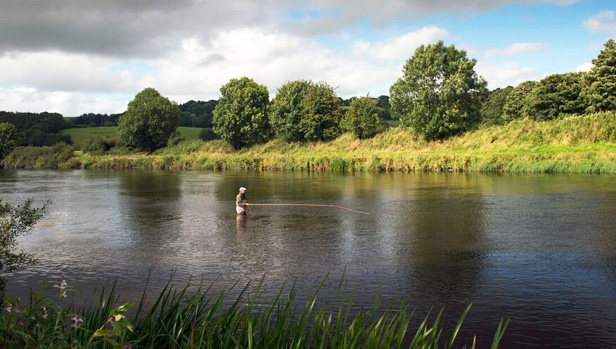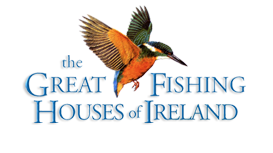

The Rivers
River Nore
The River Nore rises on the eastern slopes of the Devil’s Bit Mountain in Co Tipperary and, at first, flows east through Borris in Osory and then turns south through Co Kilkenny, passing through Durrow, Ballyragget, Kilkenny City, Bennettsbridge, and Thomastown before meeting the tide at the lovely village of Inistioge. It is 87 miles long and drains a total catchment of 977 square miles. It rises on a sandstone base but the catchment soon turns to limestone and remains so to the sea. The countryside is one of mixed farming, with some tillage, quite a bit of pasture and dairying and some bloodstock. The river has a fairly steep gradient but the flow is checked by innumerable weirs and it is probably true to say that shallow glides are the predominant feature.
Wading is quite safe, and necessary in many areas (body waders) for the trout fishing. The banks are lined with trees in many places. Aquatic vegetation is less than its sister rivers, the Barrow and Suir.
The best of the salmon fishing is said to extend up as far as the confluence of the River Dinin and the best trout fishing is upstream of Thomastown, though there is some below it too.
This was once one of the finest salmon rivers in the country, but has declined dramatically recently. It now gets very few spring salmon. The grilse run fluctuates and so too does the autumn run. The peak of the grilse fishing is from mid-June till early July and the autumn run arrives some time after mid-August. These fish can be big – from 12 to 20 lb – but the run is uncertain.
As far as the brown trout are concerned, a survey carried out in 1990 by the Central Fisheries Board revealed an excellent stock. The survey team reported huge numbers in some areas. The average size is 10 - 12 oz, with few fish over 1 lb.
The best of the trout fishing is from early season to mid-June on the tributaries and throughout the season on the main river.
I do not have a great deal of information on fly hatches. There are some olives’ and stoneflies appear to be important early in the season. There are big numbers of various sedges. It is definitely a river where the visiting trout angler could usefully bring his fly-tying kit along.
The ownership of the fisheries is well defined and the fishing rights are either exercised by the individual owners or leased to clubs and angling associations.
Mount Juliet House has 3 miles of double-bank fishing on the Nore upstream of Thomastown and a further miles of fishing on the right bank of the King’s River, extending upstream from the confluence. The fishing is divided into ten beats and both trout and salmon fishers are catered for.
The salmon fishing is mostly grilse and autumn fishing can be very good. In 1988 this stretch produced 271 fish but the 1989-90 figures were only a small fraction of the 1988 catch. All fishing methods are allowed.
The brown trout fishing is very good on this stretch in April and the evening fishing can be magic through July and August.
Salmon rods are let by the day and there are evening permits for the trout fishing. Gillies are available by prior arrangement and fishing tackle can be hired.
Excerpts taken from "Trout & Salmon Rivers of Ireland, an angler's guide" by Peter O'Reilly.

